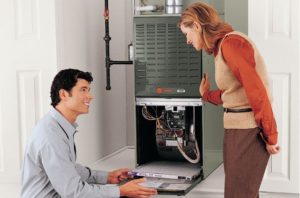There are different types of furnaces available and each type has their own set of features, pros and cons. Two main types of burners used residentially and industrially are the oil furnace and the gas furnace. About 50% of American homes are heated with gas today, versus about 8% of homes with oil heat via a residential oil furnace. If you are a home or business owner wanting to keep your indoor areas cozy, it is imperative to research the differences between oil furnaces versus gas units in order to make a decision that is right for your budget and needs. There are electric furnaces too, but these are normally used in areas where the winter is milder.
Oil vs Gas Furnaces
Above all, you need to consider the Annual Fuel Utilization Efficiency (AFUE), which measures the efficiency of a machine’s combustion. A new oil furnace will usually have an AFUE rating between 80-90%, and a new gas furnace will usually have an AFUE of 89-98%. Some customers choose the gas units for the long-term efficiency and energy savings, recovering their initial cost for the higher unit price after the first few years. However, the new models of oil furnaces available today are much more energy efficient than they were a decade ago. An example of a relatively efficient residential oil furnace is the Bryant Preferred Series, which operates quietly and efficiently with an AFUE rating of up to 86.6%. Coming in close to Bryant’s efficiency is the Rheem’s Classic Series of highboy/horizontal profile oil furnaces, which has three firing rates, limited lifetime warranty, and an efficiency rating of up to 86.5%.
Oil Furnace Benefits
 One benefit of an oil furnace is that it emits more heat than other heating sources, but an on-site storage tank is required and oil must be delivered. Domino’s Furnace Service is able to help you install your new oil furnace and service it regularly once installed. One of the downsides of owning an oil furnace is that chimneys must be cleaned and the oil filters changed frequently. This brings us to the benefits of having a gas furnace. A gas furnace is cheaper to maintain and rarely breaks down. Natural gas is the cheapest fossil fuel available as well as the cleanest and the most efficient. 90% of the natural gas that enters the pipeline reaches you, the consumer, so only 10% of the energy is lost in the process. Additionally, if you remember that electricity is usually produced by burning fossil fuels, which produces as many waste products as heating through burning fossil fuels directly, it is clear that natural gas furnaces have this advantage over electrical heating systems as well. In Alabama, natural gas homes produce 50% less carbon emissions than all-electric homes. The average gas furnace cost is around $1200, with an average installation cost of around $2300. These represent prices for an average house with average needs, which is an 80,000 BTU furnace with a 3-Ton blower that is installed in a first-floor utility room of a 1600-2000 square foot house. The brands that make oil furnaces, such as Bryant and Rheem, also make gas furnaces.
One benefit of an oil furnace is that it emits more heat than other heating sources, but an on-site storage tank is required and oil must be delivered. Domino’s Furnace Service is able to help you install your new oil furnace and service it regularly once installed. One of the downsides of owning an oil furnace is that chimneys must be cleaned and the oil filters changed frequently. This brings us to the benefits of having a gas furnace. A gas furnace is cheaper to maintain and rarely breaks down. Natural gas is the cheapest fossil fuel available as well as the cleanest and the most efficient. 90% of the natural gas that enters the pipeline reaches you, the consumer, so only 10% of the energy is lost in the process. Additionally, if you remember that electricity is usually produced by burning fossil fuels, which produces as many waste products as heating through burning fossil fuels directly, it is clear that natural gas furnaces have this advantage over electrical heating systems as well. In Alabama, natural gas homes produce 50% less carbon emissions than all-electric homes. The average gas furnace cost is around $1200, with an average installation cost of around $2300. These represent prices for an average house with average needs, which is an 80,000 BTU furnace with a 3-Ton blower that is installed in a first-floor utility room of a 1600-2000 square foot house. The brands that make oil furnaces, such as Bryant and Rheem, also make gas furnaces.
If you would like to know more about the differences between oil and gas furnaces, and need advice on which one is right for you, give Domino’s Furnace Service a call. We would be pleased to offer our expert advice tailored to your situation.



